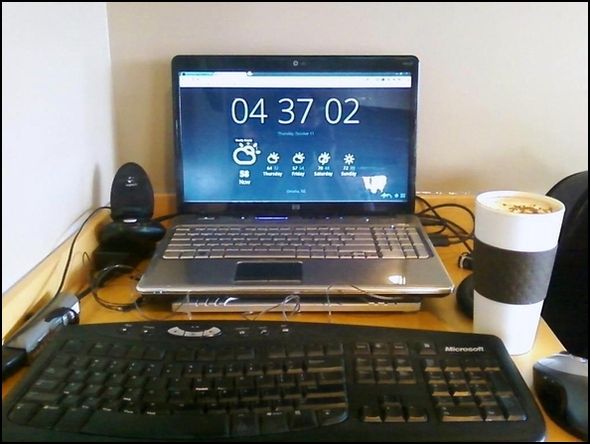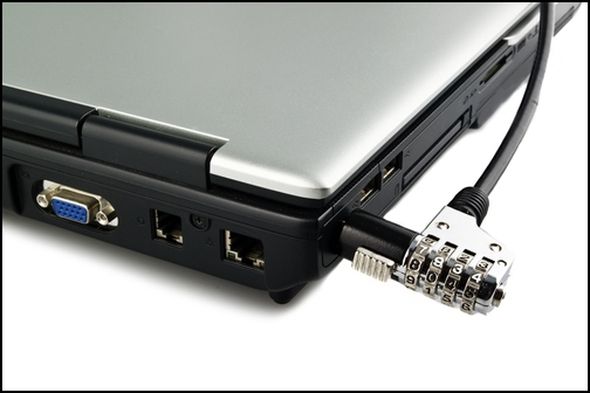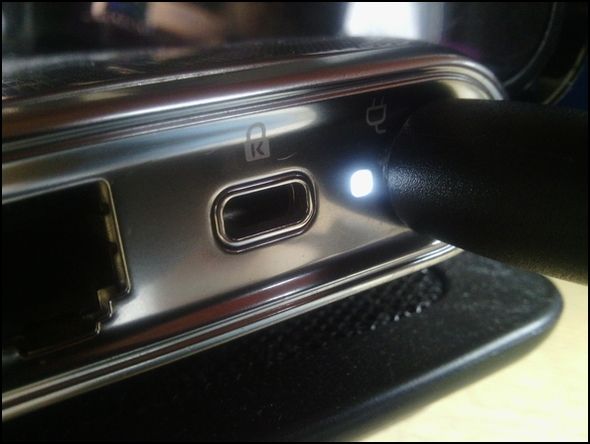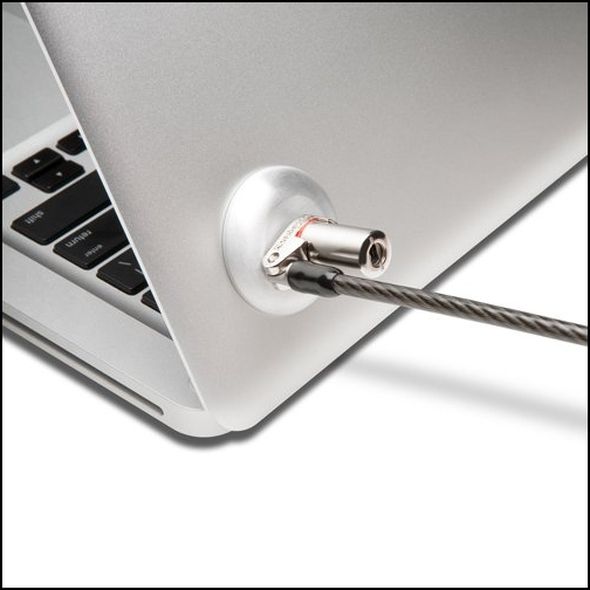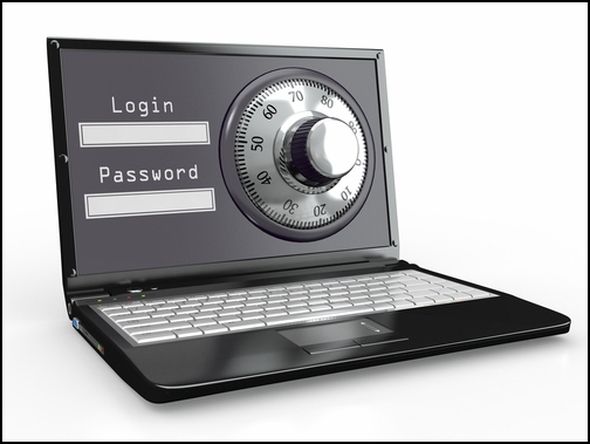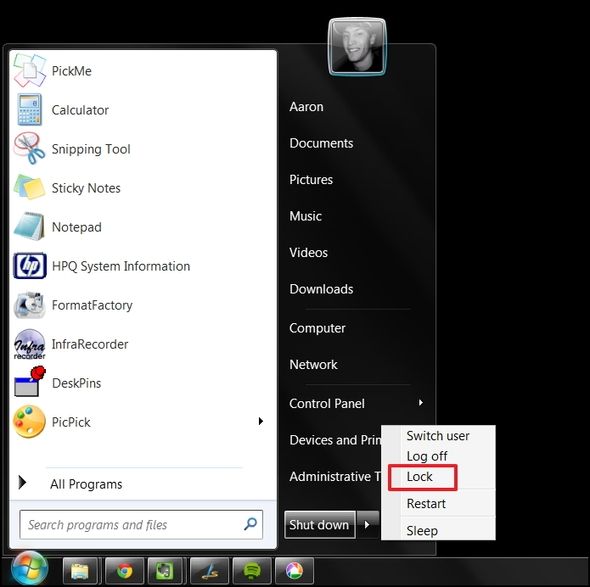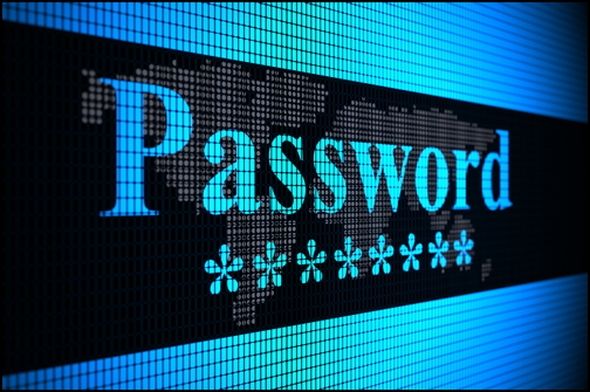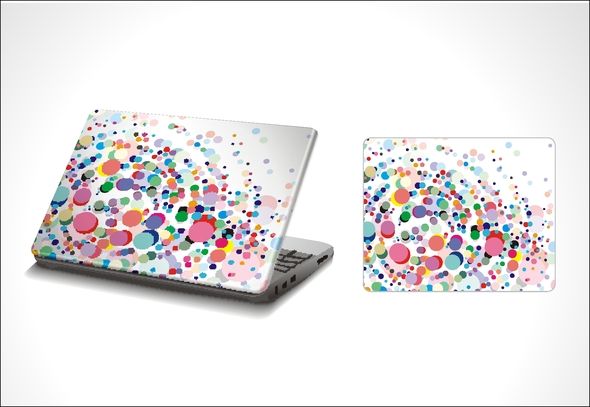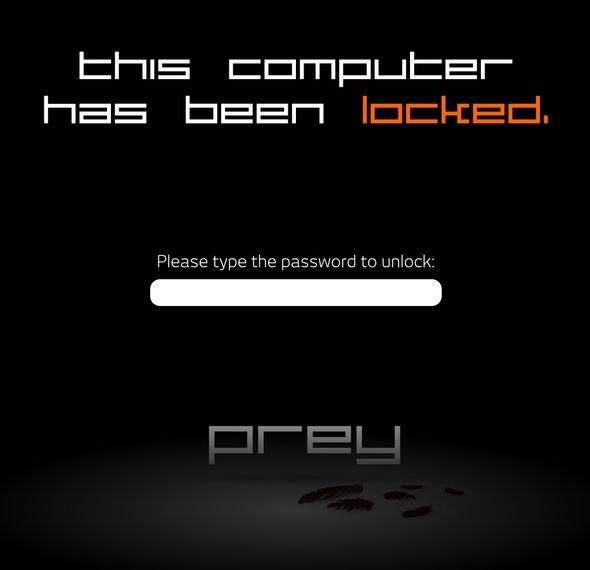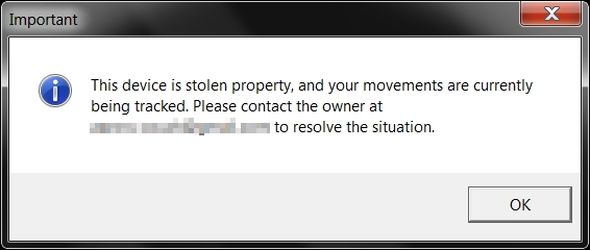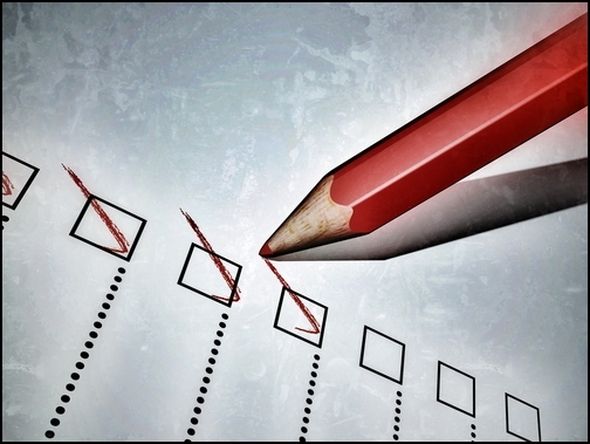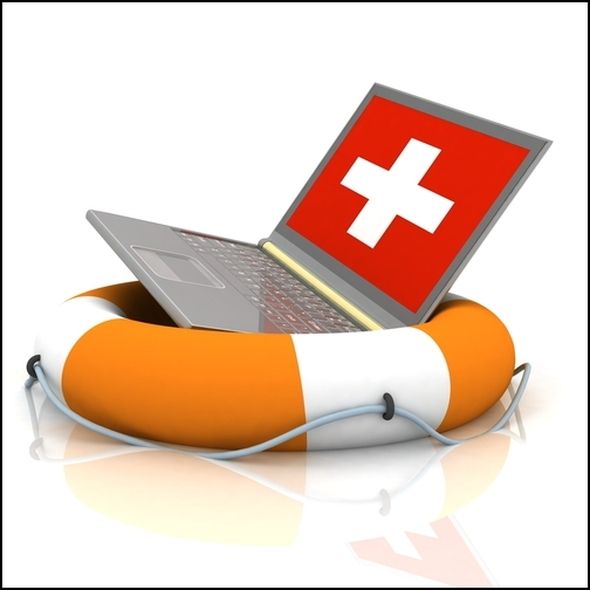Ideally we would never leave our laptops from our sight, especially in public. And there are definitely areas like airports and public transit where you should never consider it an option. But since becoming a tech writer, I've found that public areas, specifically coffee shops, are great for working. And because I’m in coffee shops 400% (yes, I did the math…) more than I used to be, I've noticed the need to occasionally leave my spot to go somewhere, whether it’s the restroom, the counter for a refill or snack, or even running out to the car.
Personally, it’s a bit more difficult for me as I often lug a lot of stuff with me. I may travel lighter with only a cooling pad. But other times, I bring my wireless keyboard and mouse, headphones, external hard drive, etc. Either way, it often seems impractical to put everything away and take it with me just to leave my spot for 5 minutes. Plus, without something marking your spot, you risk losing it – which is a big deal when power outlets are as valuable as the free Wi-Fi.
This article will cover several precautions (not guarantees) to take to help you feel safer about when you’re away from your laptop. But these don’t just have to apply to when you’re in a public place. How about a dorm room, work cubicle or some other "mostly safe" place? These all can keep your gear safe there too.
Invest In A Laptop Security Cable
The word "invest" makes this sound like a big expense, but don’t let that deter you. You can pick a great one up for around $30 on Amazon. Of course there are other models which are on either side of that price range. The are a couple of options to look at when considering a security cable - key or combination (pictured below).
One isn't necessarily better than the other – it mostly comes down to preference. However, after reading one particular review on a security cable with the combination option, I became a bit more leery of combination locks due to the risk of accidentally resetting the combination and having to cut the lock off.
I read in the instructions about the risk of accidentally resetting the combination, and the manufacturer cautioned that there was no remedy for this. I didn't worry, cause I thought, "Only a dummy would do that, and I'm no dummy." Well guess what? Like some other posters, I accidentally reset my combination while normally applying the lock, and now I have to cut it off my computer.
A comment on this review even mentioned this happening to a Kensington lock with the combination function, which is ironic because they are the company behind this function on laptops, external hard drives, projectors and other similar technology.
So where is this port and what does it look like? It’s a small slot on either which will likely be on the side or back of your laptop, aptly called the K-slot, and can be either vertically or horizontally – depending the the computer.
If you’re looking for it and can’t find something that looks like the image above, do you have an ultrabook? However, some ultrabooks, such as the MacBook Air, don’t have this. If you’re in this boat, a lock like the MicroSaver K64994AM by Kensington (pictured below) is a good solution. It fits into the regular K-slot, but also comes with an adaptor for those without a K-slot.
Lastly, as you should always do when shopping online, check out the reviews before buying – they can give you a pretty good picture on the quality of the product and the company’s customer service – which is just as important. It’s also good to keep in mind that not all brands are made equal. Am I saying that Kensington is the only brand you should go with? No, but they are reputable, have excellent policies and will stand behind their products.
Should you decide use another company that makes a “Kensington compatible” product, you risk getting a cheaper product and service. A perfect example of this, despite the majority of decent user reviews, was the review mentioned at the beginning of this section.
Keeping all of that in mind, here are the best laptop security cables on Amazon to get you started.
Keep Things Hidden, But Also Connected
Obviously, don’t leave a wireless mouse just sitting at the edge of a table – make as much of it inconspicuous as possible. In addition to that, leaving as much connected to your laptop as you can will actually be a deterrent in itself, especially when combined with a security cable. People are looking for the quick “snatch-n-grab” not the cumbersome “unhook-this-unplug-that-oops-a-cord-got-caught-and-knocked-over-a-chair.”
Lock Your Screen
This is a pretty basic, but perhaps you didn’t you can lock your account again after the initial login into your computer. I recommend just doing this through keyboard shortcuts.
Screen locking in Windows
Of course, you can go to the Start menu and lock the screen that way. But what’s faster is pressing [Start/Windows + L].
If you want to try an alternative to the default Windows Lock Screen, the transparent desktop lock, ClearLock, might be a good option.
Screen Locking In Mac
The keyboard shortcut [Control + Shift + Eject] will turn the display off, but an additional step must be taken in order to enable the screen to be locked whenever the display is turned off. To do this open the Software Preferences, click Security and check Require Password.
In addition, we recommend the program QuickLock, covered by Justin, which allows allows you to lock your Mac quickly. In the end of that article Justin also covers how to lock your Mac right from the taskbar with Keychain access in Utilities.
Screen Locking In Linux
To quickly lock your Linux machine, use the keyboard shortcut [Ctrl + Alt + L].
Create A Secure Password
The lock screen is only as good as the password you have. Tina has written an excellent article to create a good password that you won’t forget and I strongly recommend following her guidelines. Here are some things to do when making a password:
- Don’t use any real word.
- Combine upper and lower case letters with numbers and special characters.
- Use the first letter of every word in a phrase that means something to you.
- Subtract letters with numbers where applicable (e.g. “1” instead of “i”).
These are just a few of the tips, but they certainly don’t fill the place of Tina’s article, so read that for more detail in creating awesome passwords.
Get To Know The Employees At The Venue
One of the benefits of becoming a regular at a coffee shop, library or any public place is that you can build relationships with the people who work there. They appreciate your business and want to do what they can to help you. And as long as they aren’t super busy, they’ll probably notice you get up and leave, or you can even just ask them to keep an eye on your stuff while you step away for a couple minutes. Either of these are likely enough if you have a good relationship and are sitting reasonably close to where they’re working.
Some Other Related Tips
In addition to building a relationship with the employees and even the owner(s). There are a couple of other things you can do:
- Pick a spot in a relatively open area with people around, but not high traffic.
- Ask someone you think is responsible after looking at them for five seconds to watch your stuff.
The idea with sitting in an open area is that people will notice you and also notice that someone who isn't you is attempting to take your stuff. If you follow the other guidelines, such as putting a cable in place, they’re going to make a scene. Whereas if you were in some back corner where no one else was and you left your stuff, the thief wouldn't be as easily deterred, sometimes even with a secure cable if given enough time.
When deciding whether or not to ask someone, think about where you’re at, who the person is and where you live. Here in the Midwest (United States), people are generally pretty nice, even in the big cities. I've never been to the coasts, so I don’t know how people in general are there. Obviously there are nice people all over this world, so you just have to find someone who is willing to watch your gear for a few minutes.
Don’t Use Explicit Storage – Disguise Your Laptop
Nothing says “Laptop!” like a laptop sleeve… and maybe even a messenger bag. Backpacks are a bit more bulky and thus more obvious if one is being taken. Don’t get me wrong, laptop-sized sleeves and cases are great – I use one, but when leaving it in places like your car or beside a table, try to have them less conspicuous in placement and perhaps in another less-obvious bag.
Also, there are creative ways to decorate your laptop and make it stand out. What? Aaron, you just said to make your laptop less obvious… Yes – the case. But if you’re leaving it out on a table, plugged in, perhaps it standing out is a better option. Someone who walks by and notices it pop out because it’s different is likely also going to notice someone, not you, having the same one. You can decorate it with stickers of interest and choice, custom back plates from your laptop’s manufacture, or skins and decals, which you can get on Amazon or other places online.
Use Applications Which Aid In Preventing Theft
From apps that can help you track down the perpetrator who took your laptop to programs that turn your webcam in to a motion detector, there are tools at your disposal. One of the coolest services is Prey, which Justin wrote about on MakeUseOf.
https://www.anrdoezrs.net/links/7251228/type/dlg/sid/UUmuoUeUpU61396/https://vimeo.com/18728980
Prey offers some really unique features including:
- Geolocation.
- 30-second alarm.
- Alert message.
- Lock screen.
- Screenshot.
- Webcam image.
In addition, you can use programs like iSpy or other motion detection software to enable you to see who took your laptop.
http://youtu.be/WLZRow9S7UY
How do you get this video though if it was on your computer, which is now gone? When setting up the motion detection software, which sometimes is even a feature in various versions of the default webcam software, locate where those videos will be saved. Then use a program like SugarSync to automatically sync those files to the cloud any time a new file is detected. If you use another service other than SugarSync that doesn't have the capability of syncing any folder on your computer (e.g. Dropbox, Google Drive), use the program Duplicati.
There is all kinds of information on this topic on MakeUseOf. Here’s some more helpful links:
- Use Your Webcam For Home Surveillance With These Tools
- How To Set Up An Anti-Theft Alarm On Your Mac Laptop
- How to Find the Guy Who Stole Your Phone, Tablet or Laptop
- 5 Things You Can Do To Potentially Retrieve Your Stolen Laptop
- How To Prepare Your Laptop For A Case Of Theft
Create An Inventory Of All Your Accessories
If you need to leave your laptop briefly, it’s probably because it’s not just as simple as picking it up and taking it with you. You might have a hard drive, wireless mouse, cooling pad, and whatever else plugged into it. So it’s not a bad idea to have an inventory of everything you have and check it over before you leave and when you come back. Services like Evernote, a text document in Dropbox or a doc in Google Drive work great for this.
Don’t Take The Risk – Insure It
Contrary to popular belief, laptop insurance is probably one of the smartest things you can do. However, I don’t recommend going with the big box store or manufacture warranties – those are a rip off. There are two companies that I personally recommend - Safeware and SquareTrade. I believe these are only available in the U.S., so if you live elsewhere, check around the Internet for reputable and affordable insurance companies. Another company that we’ve slightly covered on MakeUseOf in the article Should You Consider Buying Insurance For All Your Gadgets? is ProtectYourBubble, which I haven’t had any personal experience with.
I have worked with Safeware and they’re good. SquareTrade, however, has some of the best prices without a drop in value. These prices are even better if purchased through Amazon. Some feel that it’s a waste of money and that you might as well put the money towards a new one. But I differ with that. $150 is better than spending $700, no? If an accident happens and you don’t have accidental coverage, you’re out of luck.
Conclusion
Can these guarantee to protect your laptop from theft? No. But when you put several of these together, your chances of being a victim of theft decrease tremendously (no scientific proof, just logical assumption).
Do you ever leave your laptop in public? If so, what strategies do you use to prevent theft? Do you use something of your own that wasn't covered here?
Image Credits: Kensington Ultrabook Lock via Amazon, Combination Laptop Lock via Shutterstock, Laptop Screen Lock via Shutterstock, Professional Laptop Sticker Skin via Shutterstock, Notebook Lifesaver via Shutterstock, Pencil Checklist via Shutterstock, Password via Shutterstock


